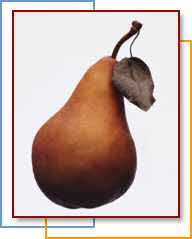Home | FOOD ARTICLES | Food Trivia | Today_in_Food_History | Food_History_Timeline | Recipes | Cooking_Tips | Food_Videos | Food_Quotes | Who’s_Who | Culinary_Schools_&_Tours | Food_Trivia_Quizzes | Food_Poems | Free_Magazines | Food_Festivals_and_Events
Food Articles, News & Features Section
FREE Magazines
and other Publications
Free Professional and Technical Research, White Papers, Case Studies, Magazines, and eBooks
PEARS
See Also: Pears Article 2; Pear Trivia; Pear Kitchen Tips; Pear Quotes
Pears (Pyrus communis) are a pome fruit relative of the apple. One of the earliest written histories or records comes from Homer's reference to them as "Gifts from the Gods." The first pears arrived in the United States by European settlers in the 1700s. Pears rank second to the apple as the most popular US fruit. They can be eaten and used in a lot of the same ways as the apple. One distinct feature of the pear besides the shape is the soft texture. This soft texture is the result of the starch converting to sugar after being picked from a tree to ripen. (Wellness Encyclopedia of Food and Nutrition, 1992).
The very shape of a pear speaks of its luscious nature. When ripe and ready to eat, the pear has a honeyed flavor and beckoning perfume that bewitch your senses. There are more than 3000 known varieties in the world. US production comes from states in the Northwest, plus New York, Pennsylvania, Michigan, and California. Imports come from South America, Canada, New Zealand, and South Africa.
With the numerous varieties and extended growing seasons, pears of all sizes and colors are available year-round.

Varieties
There are several varieties of pair including Anjou, Bartlett, Bosc, Comice, Forelle, and Seckel. These fruits have a sweet, rich flavor and come in a variety of colors including green, golden yellow and red. Among these varieties there are only subtle differences in flavor and texture.
Pear Varieties
Pears come in a variety of shapes, sizes, and colors from tiny Seckels to long-necked Boscs to colorful Red Bartletts. Check out their availability and use below.
Green Anjou — Available October through June
Firm and green, even when ripe; this large, thin-skinned yellowish-green pear is best eaten fresh. When slightly under-ripe, it can be baked or poached, but once it ripens, its sweet, mellow flavor and abundant juice make it an excellent choice for salads and snacks.
Red Anjou — Available October through May
Much the same flavor, use and texture as the green Anjou. Red Anjous (generally dark, maŲoon red in color) show little to no change in color as they ripen, which is another characteristic shared with their Green Anjou counterparts. Red Anjous are recognizable for their near egg-shaped appearance.
Yellow Bartlett — Available August through December
One of the most common and popular pears, this large, bell-shaped all-purpose pear has a yellow skin sometimes blushed with pale red. It is very sweet, juicy, aromatic and perfect for salads, eating fresh, and excellent for canning or cooking. It holds its shape and flavor in baking and cooking.
Red Bartlett — Available August through December
Firm, bright red skin, very sweet and juicy when ripe. This variety is a bit smaller, with the same flavor, texture, and use as yellow Bartletts. They make an excellent choice as a color accent in a fresh-fruit dessert o聲 salad.
Bosc — Available August through April
The Bosc has a firm, dense, yet tender flesh with brown skin that hides a deliciously, sweet and spicy flavor. Its dense flesh makes it ideal for baking and cooking. Color doesn't change as iɴ ripens, excellent for baking. Its mild, not-too-sweet flavor is great for microwave recipes, salads, and snacks.
Comice — Available August through March
Is hard, green, and rounder than a Bartlett, but similar in flavor and texture. One of the largest, sweetest and juiciest varieties. Best used fresh in salads, served as an elegant dessert pear, or as an excellent accompaniment with cheese.
Forelle — Available September through February
Slightly larger than a Seckel, with freckled skin and a red blush. For what they lack in size, Forelle pears make up in sweet flaŶor and beautiful appearance. They're an excellent snack or lunch-box pear…sweet, juicy, and crisp.
Seckel — Available August through February
Tiny pears with ultra-sweet flavor, so sweet in fact they are called "sugar pears." Maroon and olive green in color, with no color change when ripened. They are an excellent choice for children's snacks, pickling, or as a garnish.
Fresh Pears are a Healthy Choice!
They have no cholesterol, sodium, or saturated fat. They offer a natural, quick source of energy, due largely to high amounts of two monosacharides: fructose and glucose, plus Levulose, the sweetest of known natural sugars, found to a greater extent in fresh pears than in any other fruit. A pear is a nutrient dense food, providing more nutrients per calorie, than calories per nutrient. Carbohydrates make up 98% of the energy provided by a pear, and carbohydrates are helpful in weight reduction diets because they contain half as many calories as fat.
Fiber
Fresh pears offer dietary fiber, much of it in the form of Pectin. A pear weighing 166 grams provides 2.32 grams of crude fiber, and 4 grams of dietary fiber, of which 41% is pectin. Fiber contains no calories, and is a necessary element of a healthy diet, helping to sustain blood sugar levels and promoting regularity. High fiber diets may also help reduce the risk of colon cancer and can help reduce serum cholesterol. Pears are a good source of natural fiber.
Potassium
Fresh pears offer potassium; 210 mg in a medium size pear. Although it is an element lost easily through dehydration or perspiration brought on by active lifestyles or strenuous exercise, potassium is necessary for maintaining heartbeat, muscle contraction, nerve transmission, as well as carbohydrate and protein metabolism. Replenish potassium by eating fresh vegetables, fruits or legumes containing high potassium content— pears are an excellent choice.
Vitamin C
Fresh pears contain Vitamin C. One medium size pear provides 7 mg, or 10% of the RDA for Vitamin C. As one of the antioxidant vitamins, Vitamin C is essential for normal metabolism and tissue repair, helping prevent free radical damage the destructive by-products of the body's metabolic process. Vitamin C improves the immune system and promotes healing of cuts and bruises and guard against a number of infectious diseases. Fresh pears are a good source for Vitamin C.
Selecting
Sweet, succulent pears are perhaps the most glorious of fall fruits. Selecting them can be easy if you consider the following: avoid pears with bruises or cuts and dark brown colors; purchase pears while slightly green because they ripen better and faster off the tree; look for pears with a smooth unblemished skin; ripe ones will yield slightly to gentle pressure at the stem end. If you plan to bake pears, select those that are fairly firm.
Storing
If pears are unripe, place them in a paper bag at room temperature for 2 to 3 days or store them in a ventilated fruit bowl in a cool, dark place, and refrigerate as soon as they ripen. Ripe pears should be stored in the refrigerator in a plastic bag up to 3 days. They continue to ripen after harvest.
Wash and Eat
There's no need to peel a pear... their tender, edible skin is an additional source of fiber. A medium sized pear provides 4 grams of fiber, or 16% of the recommended daily value. Always wash all fresh fruits and vegetables before serving.
Make Pears Part of Your 5 A Day Plan 
It is easy to include pears in your 5 A Day Plan. Take a pear for lunch, either fresh, dried or in a flip top can. Snack with pears during the day. Use baked or broiled pears with a sauce as a light tasty dessert. Use pear slices dipped in lemon as a garnish to jazz up foods. Sliced thin wedges served with chunks of cheese, smoked turkey and seedless grapes on a skewer make a healthy appetizer or side dish.
Toss chopped pears into a chicken, tuna, green, fruit or cottage cheese salad. When roasting vegetables, add pear slices to the vegetable mix. Try using pear slices on your next grilled chicken sandwich. Use pears where you would use apples…… Enjoy!
RELATED ARTICLES
Please feel free to link to any pages of FoodReference.com from your website.
For permission to use any of this content please E-mail: james@foodreference.com
All contents are copyright © 1990 - 2025 James T. Ehler and www.FoodReference.com unless otherwise noted. All rights reserved.
You may copy and use portions of this website for non-commercial, personal use only.
Any other use of these materials without prior written authorization is not very nice and violates the copyright.
Please take the time to request permission.

